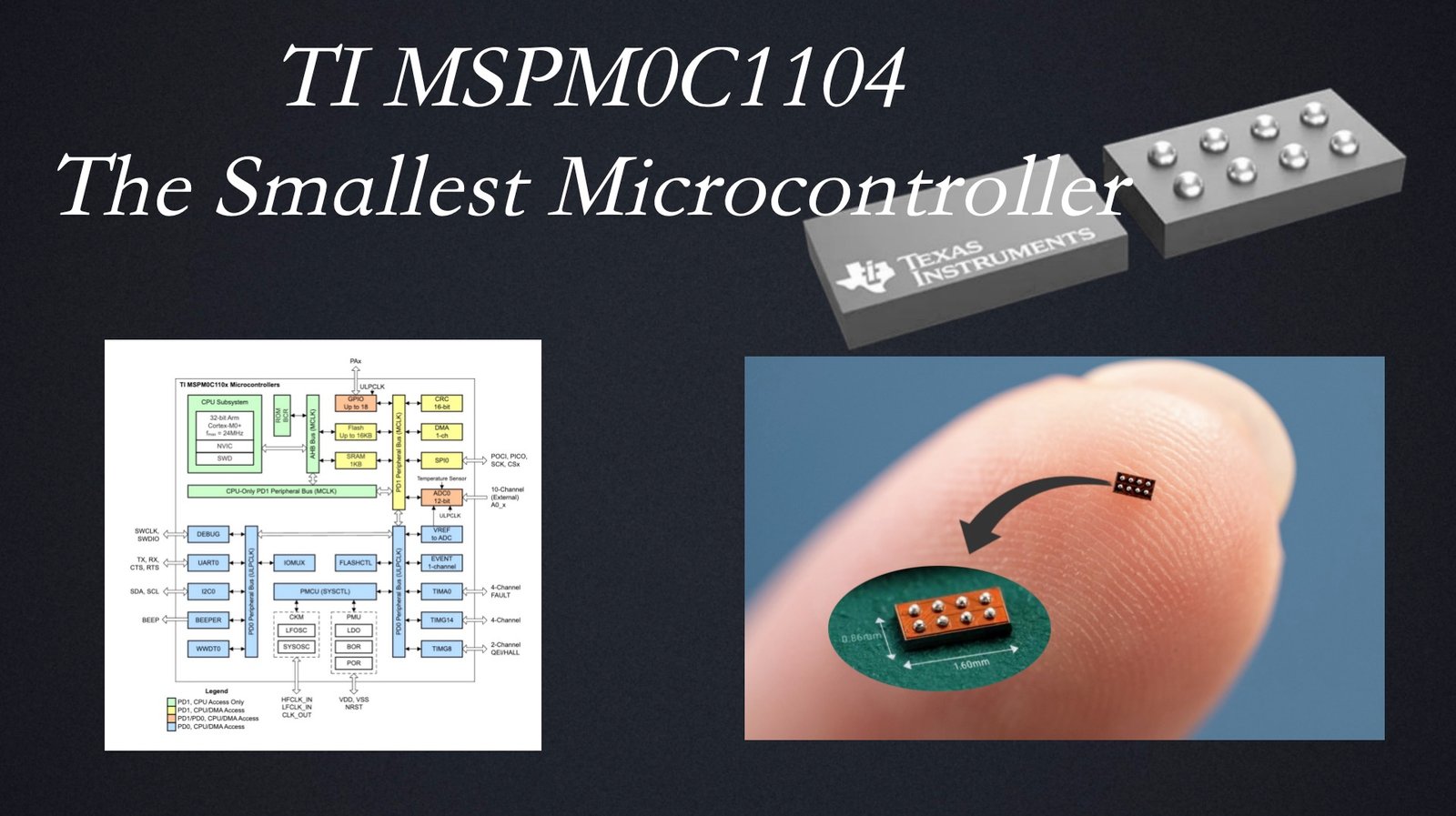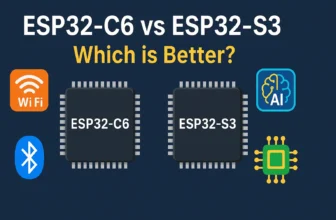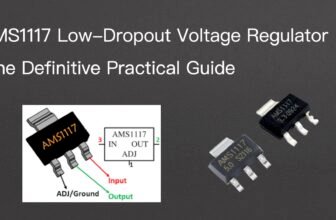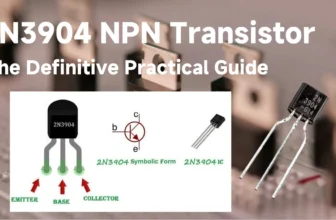
Engineers often chase the smallest microcontroller for space-constrained products, only to discover painful trade-offs in analog quality, timers, or tool support. TI’s MSPM0C1104 breaks that pattern: widely promoted as part of the world’s smallest microcontroller class in production WCSP/DSBGA packaging, yet it keeps a 24 MHz Cortex-M0+, a fast 12-bit ADC, industrial temperature range, and a developer-friendly LaunchPad. In short, it’s small where it counts—board area and BOM—without shrinking the essentials.
What Exactly Is the MSPM0C1104 Microcontroller?
The MSPM0C1104 belongs to Texas Instruments’ MSPM0 family of 32-bit Arm Cortex-M0+ microcontrollers tuned for low cost and low power. At a glance:
- CPU & clocks: Cortex-M0+ up to 24 MHz with an internal high-accuracy system oscillator and a 32 kHz low-frequency oscillator for sleep-friendly timing.
- Memory: 16 KB Flash and 1 KB SRAM (the MSPM0C1103 sibling offers 8 KB Flash for ultra-lean use cases).
- Analog: 12-bit ADC capable of high-speed sampling, on-chip temperature sensor, internal voltage references, and supply monitors.
- Digital: Up to 18 GPIOs (package-dependent), CRC accelerator, and DMA dedicated to the ADC for zero-CPU sample moves.
- Timers: One advanced 16-bit timer with complementary outputs and dead-band for motor/LED power stages, plus two 16-bit general-purpose timers for capture/compare/PWM.
- Comms: UART, SPI, and I²C with protocol assists (LIN, IrDA, DALI, Manchester, SMBus/PMBus) to keep timing deterministic without ISR acrobatics.
- Operating range: −40 °C to +125 °C, 1.62–3.6 V supply.
- Packages: From hobby-friendly TSSOP/WQFN to ultra-compact WCSP/DSBGA packages that place it squarely in the smallest microcontroller class.
These are “complete-system” capabilities, not just a token CPU in a tiny case. You can sense, drive, and communicate without bolting on external helpers.
Why the “Smallest Microcontroller” Angle Actually Matters
Ultra-Small Form Factor
The wafer-level WCSP/DSBGA variant offers a pepper-flake–sized footprint, enabling layouts where the MCU hides under a flex tail, sits beside MEMS sensors, or tucks between pogo pads. Being in the smallest microcontroller class isn’t a vanity metric—it removes layout constraints and shortens analog paths, which directly improves SNR and reduces EMI headaches.
Pennies-Per-Part Economics
Coverage around MSPM0C1104 highlights sub-$1 distribution pricing and teens-of-cents volume costs depending on package and quantity. For high-volume consumer or disposable medical devices, that’s often the difference between “nice demo” and “shippable product.”
Low-Power States You Can Use
RUN currents scale linearly with clock, and sleep modes—STOP, STANDBY with SRAM retention, and deep SHUTDOWN—are tuned so real products can sample, process, and nap without external supervisor ICs. The integrated oscillators are accurate enough to skip crystals in many designs, simplifying BOM and assembly.
Bottom line: Choosing the smallest microcontroller should not force you to compromise on analog performance, timer quality, or toolchain maturity. The MSPM0C1104 preserves all three.
Analog That Punches Above Its Weight
The 12-bit ADC (with top-end sampling rates suitable for oversampling and modest DSP) is the unsung hero. For wearables and probes, you often need:
- Fast enough sampling to track dynamic signals and average noise.
- Stable, selectable references (internal 1.4 V/2.5 V and VDD) to match sensor ranges.
- Minimal CPU overhead: ADC-to-DMA moves keep the core asleep while data streams.
Add the on-chip temperature sensor and supply monitors and you’ve got product telemetry for free. In many 0–3.3 V cases, your “analog front-end” can be a single RC filter, a bias network, and this MCU.
Digital Peripherals for Real Control Work
- Advanced 16-bit timer with dead-band: Run complementary PWM for half-bridges (micro-motors, piezo drivers, LED backlights).
- Two general-purpose 16-bit timers: Do precise pulse capture, tachometry, and multi-channel PWM without juggling ISRs.
- UART/I²C/SPI with protocol assists: Offload framing and edge-critical timing (LIN/IrDA/DALI/Manchester/SMBus/PMBus) so you can hit tight duty cycles or sensor schedules.
There’s even a beeper block for UI tones, saving a timer channel for something more interesting.
Packaging Ladder: From Breadboardable to the Smallest Microcontroller WCSP
TI’s packaging spread lets you build once and shrink later:
- 20-pin: TSSOP, VSSOP, WQFN (more GPIO, easier rework during bring-up).
- 16-pin: SOT (balanced I/O vs. footprint).
- 8-pin: SOT, WSON, and the WCSP/DSBGA option—the true smallest microcontroller footprint.
Expect up to 18 GPIOs on bigger packages, down to ~6 GPIOs on the tiniest. Plan your pin-mux early if you intend to migrate to WCSP.
LaunchPad LP-MSPM0C1104: The Easiest Way to Try the Smallest Microcontroller Class
Prototyping ultra-small MCUs is usually a pain. The LP-MSPM0C1104 LaunchPad makes it painless:
- On-board XDS110 debugger (+ back-channel UART)—no external probe.
- Compact board with a 20-pin BoosterPack header, user LED, button, and a handy RC filter footprint (great for ADC or PWM-to-DAC experiments).
- USB-powered; integrates smoothly with Code Composer Studio and TI’s Resource Explorer examples.
Street prices are typically well under $10, and sometimes closer to the cost of lunch—so teams can seed multiple benches without budget drama.
Design Notes for Space-Constrained Products
Clocking: Internal oscillators are accurate enough for high-reliability UART and consistent PWM. For fussy protocols, calibrate system frequency at boot using LF oscillator capture.
GPIO budgeting: Tiny packages give you only a handful of I/Os. Time-share UART TX for debug prints; consider an I²C GPIO expander if a single status LED would otherwise push you to a larger package.
Analog paths: Keep the RC filter flush with the ADC pin. For high-impedance sensors, use a brief pre-charge window and sample/hold timing via timer triggers to reduce source loading.
Power modes: Duty-cycle aggressively: sleep between sample windows; pick STOP when ms-class wake times matter, STANDBY for long snoozes with SRAM retention.
Noise & EMI: Short return paths, quiet ground under the MCU, and minimal stubs on sensor lines. The smaller the silicon, the more the PCB dominates signal integrity.
Common MSPM0C1104 Application
From battery-powered wearables to industrial sensing, the MSPM0C1104 brings “smallest microcontroller” footprints together with real analog, deterministic timers, and low-power modes—making it easy to embed intelligence where board area and energy are scarce. The use cases below map those strengths to practical domains—battery charging and power delivery, personal electronics, building security and fire safety, connected peripherals and printers, grid infrastructure, smart metering, communication modules, medical and healthcare, and lighting—showing the Role, Why, and Tip for each so you can move from concept to first light fast.
Smart Earbuds & Wearable Probes (Personal electronics)
Role: Sensor readout + haptics/LED + battery telemetry.
Why: The smallest microcontroller footprint sits beside radios and MEMS; the 12-bit ADC is fast enough for acoustic taps or PPG preprocessing, and low-power modes extend run time.
Key peripherals: 12-bit ADC (+ DMA), UART/I²C/SPI, advanced timer PWM, beeper block, internal refs/temperature sensor.
Tip: Use complementary PWM for tiny haptics drivers and the beeper for UI tones without burning a general-purpose timer.
Disposable Medical Cartridges (Medical & healthcare)
Role: Electrochemical sensing via ADC, I²C authentication, SPI logging to a base/host.
Why: Burst at 24 MHz for filtering/math, then drop into STANDBY with SRAM retention to save energy between sample windows.
Key peripherals: 12-bit ADC with internal references, I²C (for secure ID/EEPROM), SPI (to host/bridge), timers for deterministic sampling.
Tip: Store calibration in Flash; report drift/health over I²C/UART and gate sampling with timer-triggered conversions.
Pocket-Scale Motor / LED Drivers (Personal electronics · Lighting applications)
Role: LED current control, micro-servo or micro-pump positioning, backlight dimming.
Why: The advanced timer’s dead-band enables clean complementary PWM for half-bridges; tight loop timing without an external driver IC in small loads.
Key peripherals: Advanced timer (complementary PWM + dead-band), GP timers, ADC for current/voltage feedback.
Tip: Sense LED/coil current across a shunt into the ADC and close the loop in firmware; use DMA to acquire samples with minimal CPU overhead.
Battery Charging & Management
Role: Fuel-gauge polling, thermistor/pack voltage sensing, charger state control, safety cutoffs.
Why: High-impedance sensing with the 12-bit ADC and accurate internal references enables low-part-count battery telemetry.
Key peripherals: ADC (+ internal Vref), timers for periodic sampling, I²C to smart battery/charger ICs, GPIO for FET/enable lines.
Tip: Trigger ADC from a timer and run moving-average/IIR filtering; wake on timer, sample, decide, and return to STANDBY.
Power Supplies & Power Delivery
Role: Supervisory control for compact buck/boost/LED drivers or PD policy companions; fault monitoring and sequencing.
Why: Deterministic timers and fast ADC help implement soft-start, OVP/UVP, current limit, and telemetry without a large MCU.
Key peripherals: Advanced timer PWM, ADC for voltage/current sense, UART/I²C/PMBus for power-stage communication.
Tip: Use capture/compare to timestamp faults; keep a circular DMA buffer for post-event diagnostics.
Building Security & Fire Safety
Role: Sensor node for PIR/door contact/smoke chamber readout; sounder/indicator control; bus or RF module interface.
Why: Tiny footprint + industrial temperature range supports dense panels and peripherals; low sleep currents enable long-life battery nodes.
Key peripherals: ADC for analog sensors, timers for sounder patterns, UART/I²C/SPI to transceivers, beeper block for alarms.
Tip: Implement debounce and sensor self-tests on a periodic timer; log health counters to Flash.
Connected Peripherals & Printers
Role: Low-cost controllers for sub-assemblies (feed motors, sensors, UI beepers/LEDs) and housekeeping MCUs.
Why: Complementary PWM for small actuators, ADC for encoder/photodiode feedback, serial links to the main SoC.
Key peripherals: Advanced/GP timers, ADC, UART/SPI/I²C.
Tip: Use back-channel UART during bring-up for easy diagnostics; migrate to I²C for production status packets.
Grid Infrastructures
Role: Auxiliary supervisor in protection/telemetry modules, panel-level sensors, simple power-quality taps.
Why: Industrial temp range and small packages fit dense boards; ADC + timers enable synchronized sampling windows.
Key peripherals: ADC, timers (time-stamped sampling), UART/RS-485 transceiver interface via GPIO/UART.
Tip: Gate measurements to quiet line windows; average multiple cycles to improve SNR without higher CPU load.
Smart Metering
Role: Sensor front-end helper (voltage/current/temperature), LCD/indicator and relay/triac control.
Why: Deterministic PWM and timer-triggered ADC sampling provide stable metrology assistance at ultra-low cost.
Key peripherals: ADC with DMA, timers, GPIO for relays/SSRs, I²C to metering ASICs.
Tip: Keep ADC/DMA double-buffered; process one buffer while the other acquires to maintain constant throughput.
Communication Modules
Role: Side-band controller for RF modules (BLE/Wi-Fi/Sub-GHz): power sequencing, mode pins, basic diagnostics, sensor attach.
Why: Minimal BOM, tiny PCB area, and robust UART/SPI/I²C make it ideal as a “little brain” next to a radio.
Key peripherals: UART (AT/HCI), SPI (module control), I²C (sensors), timers (heartbeats/watchdogs).
Tip: Implement a low-power heartbeat and brownout telemetry to help the host diagnose RF brownouts and latch-ups.
Medical & Healthcare (Non-disposable)
Role: Wearable patches, patient monitors, accessory probes needing light compute + reliable analog.
Why: 12-bit ADC with internal refs, low-power modes, and small packages suit comfort-critical wearables.
Key peripherals: ADC, timers, I²C to biosensors, SPI to storage/radio.
Tip: Schedule sampling around motion (if available via IMU interrupt) to reduce motion artifacts.
Lighting Applications
Role: Dimming/backlight control, indicator patterns, lightweight constant-current regulation loops.
Why: Complementary PWM and dead-band drive small half-bridges cleanly; ADC closes the current loop.
Key peripherals: Advanced timer PWM, ADC feedback, GPIO for enable/fault.
Tip: Use timer-synced ADC sampling at a fixed PWM phase to minimize ripple in current measurements.
How to choose the right part quickly
- Need fast bring-up? Start with LP-MSPM0C1104 (on-board XDS110, BoosterPack header, user LED/button, RC node for ADC/PWM demos).
- Pin budget ≥14? Consider MSPM0C1104SDYYR (16-pin SOT) or MSPM0C1104SRUKR (20-pin QFN).
- Ultra-small footprint? MSPM0C1104SDDFR / MSPM0C1104SDSGR (8-pin SOT/WSON).
- Automotive compliance? M0C1104QDYYRQ1 / M0C1104QDDFRQ1 (AEC-Q100).
Each scenario above keeps your design in the smallest microcontroller class—leveraging the 12-bit ADC, deterministic timers, and low-power states—without off-loading to external analog or timer ICs.
Quick Comparison: “Smallest Microcontroller”
| Feature | MSPM0C1104 | What It Means in Practice |
|---|---|---|
| Max clock | 24 MHz | Enough for control, filtering, and protocol glue without a power spike. |
| Flash / SRAM | 16 KB / 1 KB | Tight but workable with driverlib + a lean main loop. |
| ADC | 12-bit, high-speed | Oversample, filter, and still sleep; DMA avoids CPU babysitting. |
| Timers | 1× advanced + 2× GP | Complementary PWM (with dead-band) plus robust capture/compare. |
| Comms | UART, I²C (FM+), SPI | Sensor/radio-friendly; protocol assists save cycles. |
| GPIO | Up to 18 (pkg-dep.) | Choose package to match I/O budget; migrate to WCSP later. |
| Temp / V | −40 °C…125 °C / 1.62–3.6 V | Industrial range at consumer cost. |
| Package floor | WCSP/DSBGA | A production-ready smallest microcontroller footprint. |
Many “tiny” MCUs cut ADC speed, timer features, or temperature range. The MSPM0C1104 keeps a full control/measurement toolbox in a vanishingly small package.
MSPM0C1104 Parts Ordering Options
To help you choose the right device—or just get hands-on quickly—here’s a quick reference of common MSPM0C1104 part numbers plus the official LaunchPad dev kit. “Automotive (Q1)” parts are AEC-Q100 qualified; “Catalog” parts target general embedded use. Package choice mainly drives available pins and footprint, while the LaunchPad accelerates bring-up and prototyping.
| Manufacturer Part Number | Description |
|---|---|
| M0C1104QDYYRQ1 | Automotive-grade (Q1) MSPM0C1104 MCU. 24 MHz Arm Cortex-M0+, ~16 KB Flash / 1 KB SRAM (family typical), 14 I/O pins. 16-pin SOT package; compact for automotive sensing/control. |
| M0C1104QDDFRQ1 | Automotive-grade (Q1) MSPM0C1104 MCU. 24 MHz Arm Cortex-M0+, ~16 KB Flash / 1 KB SRAM (family typical), 6 I/O pins. Ultra-small 8-pin SOT; ideal where minimal pins/footprint are critical. |
| MSPM0C1104SRUKR | Catalog MSPM0C1104 MCU. 24 MHz Arm Cortex-M0+, ~16 KB Flash / 1 KB SRAM (family typical), 18 I/O pins. 20-pin QFN; strong I/O density in a small outline. |
| MSPM0C1104SDYYR | Catalog MSPM0C1104 MCU. 24 MHz Arm Cortex-M0+, ~16 KB Flash / 1 KB SRAM (family typical), 14 I/O pins. 16-pin SOT; compact control/measurement node. |
| MSPM0C1104SDDFR | Catalog MSPM0C1104 MCU. 24 MHz Arm Cortex-M0+, ~16 KB Flash / 1 KB SRAM (family typical), 6 I/O pins. 8-pin SOT; minimal-pin variant for ultra-small designs. |
| MSPM0C1104SDSGR | Catalog MSPM0C1104 MCU. 24 MHz Arm Cortex-M0+, ~16 KB Flash / 1 KB SRAM (family typical), 6 I/O pins. 8-pin WSON (no-lead) with exposed pad; very small footprint. |
| MSPM0C1104SDGS20R | Catalog MSPM0C1104 MCU. 24 MHz Arm Cortex-M0+, ~16 KB Flash / 1 KB SRAM (family typical). 20-pin VSSOP; more pins in a narrow, fine-pitch body. |
| LP-MSPM0C1104 | LaunchPad development kit for MSPM0C1104. On-board XDS110 debugger with back-channel UART, 20-pin BoosterPack header, user LED/button, simple RC node for ADC/PWM demos, USB-powered—ideal for fast bring-up and prototyping. |
Tip: Start prototyping with a 16/20-pin package (easier rework and more I/O), then migrate to the smallest package that meets your pin budget once the design is frozen.
All parts are members of TI’s MSPM0C1104 family (24 MHz Arm Cortex-M0+). Family features typically include a 12-bit ADC, timers (incl. advanced PWM), and UART/I²C/SPI; specifics can vary slightly by package/pinout.
“Automotive-grade (Q1)” indicates AEC-Q100–qualified variants.
I/O counts are taken from your listing. If you’d like, I can add columns for package dimensions, temperature range, and typical peripherals per package.
FAQ About MSPM0C1104
Q: Is the MSPM0C1104 the smallest microcontroller?
A: It sits among the smallest microcontroller devices available in production WCSP/DSBGA packages while still offering practical analog, timers, and industrial-grade operating range.
Q: Why pick a smallest microcontroller instead of a sensor hub or ASIC?
A: Flexibility. A smallest microcontroller like MSPM0C1104 lets you iterate firmware, add features, and tune power/power-up behavior—without a custom silicon cycle or NRE risk.
Q: What should I watch out for with the smallest microcontroller packages?
A: Pin budgeting, reflow profile, and analog routing. Plan pin-mux early; keep RC networks tight to pins; validate wake-latency vs. your sensor dynamics.
Q: Can I build without external crystals?
A: In many cases yes—the internal oscillators are accurate enough for UART and PWM. For especially tight protocols, add a calibration step or an external reference as needed.
Q: Is the LaunchPad worth it if I’ll ship WCSP?
A: Absolutely. Prototype on TSSOP/WQFN LaunchPads, finalize firmware and pin-mux, then migrate to the smallest microcontroller WCSP for mass production.
Conclusion
TI’s MSPM0C1104 doesn’t just chase the “tiny” headline; it delivers a Cortex-M0+ platform with serious analog, useful timers, industrial temps, and practical power modes—all in packages that scale from hand-solderable TSSOP down to a WCSP footprint that qualifies as a smallest microcontroller in real shipping products. Pair it with the LP-MSPM0C1104 LaunchPad and you can go from USB-plug-in to measuring, modulating, and communicating in an afternoon. For ultra-compact wearables, disposable medical sensors, or cost-sensitive smart widgets, this is an easy microcontroller to recommend—and, more importantly, to ship.





